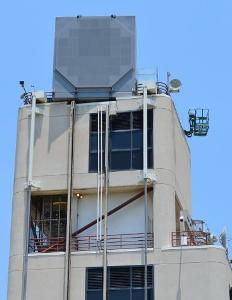Raytheon Company completed two critical program reviews for the new Air and Missile Defense Radar (AMDR), the U.S. Navy's next generation integrated air and ballistic missile defense radar. Successful completion of the hardware Preliminary Design Review and the Integrated Baseline Review are both key milestones of the Navy's acquisition plan and highlight the maturity of the design, validity of the plan for execution, and keep the program on track to deliver a much needed capability to the fleet.
 Raytheon photo: Partially-populated, full-sized Air and Missile Defense Radar array (PRNewsFoto/Raytheon Company)
Raytheon photo: Partially-populated, full-sized Air and Missile Defense Radar array (PRNewsFoto/Raytheon Company)
Customer, program and technical stakeholders from a host of Navy program offices and the Missile Defense Agency participated in both reviews, assessing the maturity of the AMDR design, its alignment to requirements, and the master plan for program execution. With many features in the advanced stages of development and a disciplined and proven process for design execution, the reviews demonstrated that AMDR's design is low risk and the program is on schedule for seamless integration onboard the DDG 51 Flight III destroyer.
"The maturity of our technologies, processes and infrastructure serves as a solid foundation for our ongoing development," said Raytheon's Kevin Peppe, vice president of Integrated Defense Systems' Seapower Capability Systems business area. "With the technology risks retired in the earlier Technology Development (TD) phase and cost reduction initiatives already implemented, we're now fully focused on the fabrication of the AMDR system and completion of the Engineering & Manufacturing Development (EMD) phase."
Throughout the multiple phases of the program to date, Raytheon has successfully demonstrated the capabilities of the system, the maturity of the technology, and the inherent innovation and flexibility of the design - which will pay dividends in its adaptability, affordability and ability to meet emerging threats for years to come.
About AMDR
For the Technology Development phase of the competition, Raytheon built a partially populated, full-sized array (see photo), including the signal and data processing back-end. Completed in 14 months, the AMDR array demonstrated the design, capability and scalability of the radar and served as the foundation for ongoing risk reduction and affordability initiatives. A 14 foot, full-size array structure was fabricated to demonstrate fit within a DDG 51 Flight III deck house, including mechanical interface, cabling, piping and maintenance elements. The array was partially populated with a small group of Radar Modular Assemblies (RMAs) containing more than 1,000 GaN transmit-receive modules, meeting TD phase requirements and representing a configuration for a smaller radar aperture. The scaled radar integrated all critical technology elements in the far-field range and rigorously exercised and tested all technologies in a relevant environment. Concurrently, Raytheon ran a series of design for manufacturing and assembly (DFMA) and cost-reduction initiatives on all the array electronics to address affordability early. With the completion of TD phase, technology risks were retired, ship fit was addressed, and affordability was designed in from the onset.
Raytheon's AMDR is the U.S. Navy's first truly scalable radar. AMDR is built with radar building blocks (RMAs) that can be grouped to form any size radar aperture, either smaller or significantly larger than today's SPY-1D(V). All cooling, power, command logic and software are inherently scalable. This innate scalability allows for new instantiations, as well as back-fits, without significant development costs. Leveraging Gallium Nitride (GaN) technology to optimize power in a smaller size, taking up less space onboard, with lower power and cooling demands, AMDR provides the DDG 51 Flight III with service life allowances to support growth for adding capabilities or adapting for future threats.
About Raytheon
Raytheon Company, with 2013 sales of $24 billion and 63,000 employees worldwide, is a technology and innovation leader specializing in defense, security and civil markets throughout the world. With a history of innovation spanning 92 years, Raytheon provides state-of-the-art electronics, mission systems integration and other capabilities in the areas of sensing; effects; and command, control, communications and intelligence systems, as well as cyber security and a broad range of mission support services. Raytheon is headquartered in Waltham, Mass. For more about Raytheon, visit us at www.raytheon.com and follow us on Twitter @Raytheon.